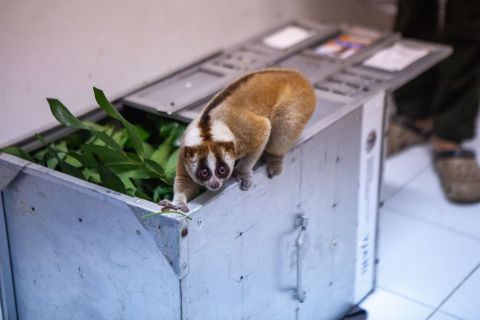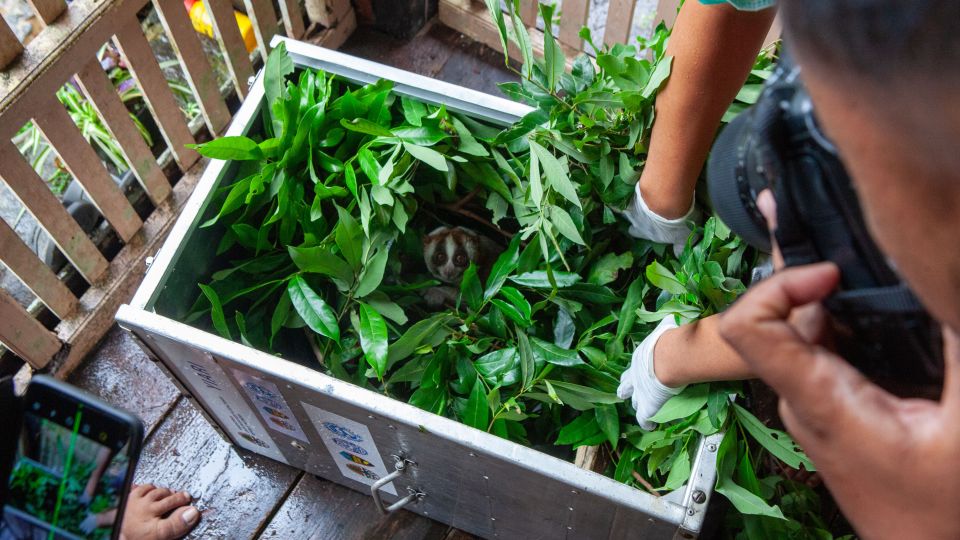
The joint team of the West Java Natural Resources Conservation Agency (BBKSDA), along with the Gunung Halimun Salak National Park Agency (BTNGHS) and the Indonesian Nature Rehabilitation Initiative Foundation (YIARI) once again carried out a series of biodiversity conservation activities in West Java, starting the year 2024 by releasing 7 (seven) rehabilitated individuals of the Javan Slow Loris (Nycticebus javanicus). These animals are protected according to the Minister of Environment and Forestry Regulation Number 106 of 2018. This release activity was carried out on Friday, January 19, 2024, in the Management Resort Area of the National Park (PTN) Mount Koneng Block Ciawitali, National Park Management Section (PTNW) III Sukabumi, Gunung Halimun–Salak National Park Agency, West Java and Banten Provinces.
The seven Javan Slow Lorises to be released consist of six male individuals named Paw-paw, Klap, Kilat, Teru, Ciban, Cibon, and one female named Ciben. These slow lorises came from reports and submissions by the community to the West Java BBKSDA and the Yogyakarta BBKSDA. Additionally, there are slow lorises that residents surrendered through wildlife rescue centres, which were entrusted to the YIARI wildlife rehabilitation centre in Ciapus, Bogor Regency, West Java, for medical treatment and rehabilitation processes before being returned to their original habitat.
The release location was determined based on information about the distribution of the natural habitat of the Javan Slow Loris (Nycticebus javanicus). The PTN Mount Koneng Resort Area, Block Ciawitali, PTNW III Sukabumi–TNGHS, is a suitable release area, as it is part of the Javan Slow Loris distribution habitat. The primary consideration in determining the release location is an area that is relatively far from settlements, relatively safe from hunting or disturbances and has available food. This location is also deemed appropriate based on a study of the suitability of wildlife release habitats conducted by TNGHS.
The TNGHS area is considered to have an abundant potential food supply for slow lorises, including Puspa (Schima wallichii), Bubuay (Plectocomia elongata), Suwangkung (Caryota rumphiana), Rattan (Calamus sp.), as well as other herbs and plants. There are also various types of insects, reptiles, and small birds like the bulbul, which are also slow loris food.
The Javan Slow Loris population is rarely found in this area, so the level of competition for food among the slow lorises to be released is low. With a low level of threats and disturbances and the social and cultural conditions of the community living adjacent to the area already having an awareness of the importance of protecting wildlife, the area meets all requirements and is suitable for the release location.

The release point in TNGHS is approximately 124 kilometres from the YIARI Rehabilitation Center in Bogor, reached by a 4-hour land journey by car, followed by approximately 30 minutes of walking.
The pre-translocation and release stages are carried out by first building a habituation cage made of nets and bamboo with an area of about 18 m2, around five units—the habituation cage functions as a means of adaptation for the slow lorises in the new location. The released slow lorises will undergo a habituation process for 4-5 days in the TNGHS area. During the habituation period, the YIARI Survey, Release, and Monitoring team observe the slow lorises’ behaviour and health. If deemed good at adapting to their new environment, these slow lorises will be released from the habituation cage into the wild. IAR CEO Gavin Bruce said, “We are delighted that the number of Slow Lorises we are rescuing has decreased. We at International Animal Rescue aim to educate by sharing our knowledge on eco-friendly practices, striving to foster a sense of respect, responsibility and empathy towards animals within the community.”
The Head of the West Java Natural Resources Conservation Agency, Irawan Asaad, S.T., M.Sc., PhD, stated, “We appreciate the joint work between the West Java BBKSDA and YIARI, as well as the BTNGHS. We are very happy because we can start the year 2024 by initiating a series of biodiversity conservation in West Java, releasing 7 (seven) individuals of slow lorises, the most wildlife saved and released by the West Java BBKSDA and YIARI. We hope this moment becomes a momentum to strengthen the bond of togetherness and the spirit of preserving protected wildlife. It must be remembered that wildlife is not for keeping; their happiness lies in the midst of the forest not in the middle of your house, let alone in a pet cage.”

